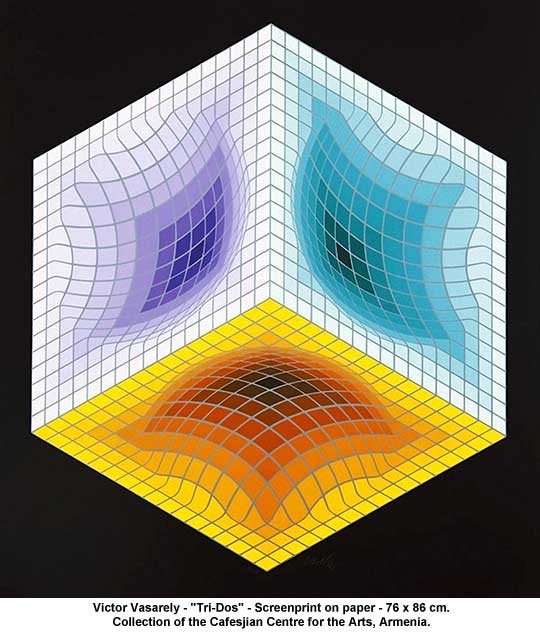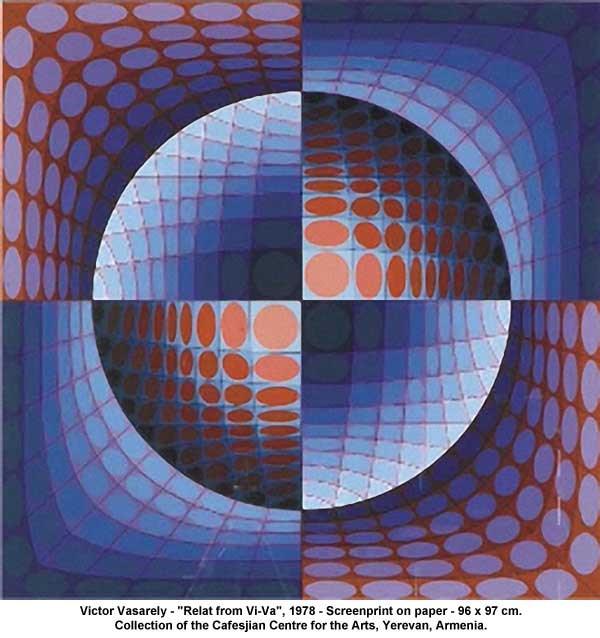The Cafesjian Centre for the Arts Opens “Victor Vasarely ~ The Father of Op-Art”
September 12, 2011 by All Art News
Filed under Art Events & Exhibitions, Featured
 Victor Vasarely was a Hungarian French artist whose work is generally seen aligned with Op-art. His work entitled ‘Zebra’, created in the 1930s, is considered by some to be one of the earliest examples of Op-art. Vasarely was born in Pécs and grew up in Pieš’any and Budapest where in 1925 he took up medical studies at Budapest University. In 1927 he abandoned medicine to learn traditional academic painting at the private Podolini-Volkmann Academy. In 1928/1929, he enrolled at Sándor Bortnyik’s workshop, then widely recognized as the center of Bauhaus studies in Budapest. Victor Vasarely became a graphics designer and a poster artist during the 1930s who combined patterns and organic images with each other. Vasarely left Hungary and settled in Paris in 1930 working as a graphic artist and as a creative consultant at the advertising agencies Havas, Draeger and Devambez (1930–1935). His interactions with other artists during this time were limited. After the Second World War, he opened an atelier in Arcueil, a suburb some 10 kilometers from the center of Paris (in the Val-de-Marne département of the Île-de-France). In 1961 he finally settled in Annet-sur-Marne (in the Seine-et-Marne département). Vasarely eventually went on to produce art and sculpture mainly focused around the area of optical illusion. Over the next three decades, Vasarely developed his style of geometric abstract art, working in various materials but using a minimal number of forms and colours. During this period, Vasarely experimented with cubistic, futuristic, expressionistic, symbolistic and surrealistic paintings without developing a unique style. Afterwards, he said he was on the wrong track. He exhibited his works in the gallery of Denise René (1946) and the gallery René Breteau (1947). Finally, Vasarely found his own style. The overlapping development are named after their geographical heritage.
Victor Vasarely was a Hungarian French artist whose work is generally seen aligned with Op-art. His work entitled ‘Zebra’, created in the 1930s, is considered by some to be one of the earliest examples of Op-art. Vasarely was born in Pécs and grew up in Pieš’any and Budapest where in 1925 he took up medical studies at Budapest University. In 1927 he abandoned medicine to learn traditional academic painting at the private Podolini-Volkmann Academy. In 1928/1929, he enrolled at Sándor Bortnyik’s workshop, then widely recognized as the center of Bauhaus studies in Budapest. Victor Vasarely became a graphics designer and a poster artist during the 1930s who combined patterns and organic images with each other. Vasarely left Hungary and settled in Paris in 1930 working as a graphic artist and as a creative consultant at the advertising agencies Havas, Draeger and Devambez (1930–1935). His interactions with other artists during this time were limited. After the Second World War, he opened an atelier in Arcueil, a suburb some 10 kilometers from the center of Paris (in the Val-de-Marne département of the Île-de-France). In 1961 he finally settled in Annet-sur-Marne (in the Seine-et-Marne département). Vasarely eventually went on to produce art and sculpture mainly focused around the area of optical illusion. Over the next three decades, Vasarely developed his style of geometric abstract art, working in various materials but using a minimal number of forms and colours. During this period, Vasarely experimented with cubistic, futuristic, expressionistic, symbolistic and surrealistic paintings without developing a unique style. Afterwards, he said he was on the wrong track. He exhibited his works in the gallery of Denise René (1946) and the gallery René Breteau (1947). Finally, Vasarely found his own style. The overlapping development are named after their geographical heritage.

Denfert refers to the works influenced by the white tiled walls of the Paris Denfert – Rochereau metro station. Ellipsoid pebbles and shells found during a vacation in 1947 at the Breton coast at Belle Île inspired him to the Belles-Isles works. Since 1948, Vasarely usually spent his summer months in Gordes in Provence-Alpes-Côte d’Azur. There, the cubic houses led him to the composition of the group of works labelled Gordes/Cristal. He worked on the problem of empty and filled spaces on a flat surface as well as the stereoscopic view. From his Gordes works he developed his kinematic images, superimposed acrylic glass panes create dynamic, moving impressions depending on the viewpoint. In the black-white period he combined the frames into a single pane by transposing photographies in two colours. Tribute to Malevitch, a ceramic wall picture of 100 m² adorns the University of Caracas, Venezuela which he co-designed in 1954 with the architect Carlos Raúl Villanueva, is a major work of this period. Kinetic art flourished and works by Vasarely, Alexander Calder, Marcel Duchamp, Man Ray, Jesús Rafael Soto, Jean Tinguely were exhibited at the Denise René gallery under the title Le Mouvement (the motion). Vasarely published his Yellow Manifest. Building on the research of constructivist and Bauhaus pioneers, he postulated that visual kinetics (plastique cinétique) relied on the perception of the viewer who is considered the sole creator, playing with optical illusions.
On 2 March 1959, Vasarely patented his method of unités plastiques. Permutations of geometric forms are cut out of a coloured square and rearranged. He worked with a strictly defined palette of colours and forms (three reds, three greens, three blues, two violets, two yellows, black, white, gray; three circles, two squares, two rhomboids, two long rectangles, one triangle, two dissected circles, six ellipses) which he later enlarged and numbered. Out of this plastic alphabet, he started serial art, an endless permutation of forms and colours worked out by his assistants. (The creative process is produced by standardized tools and impersonal actors which questions the uniqueness of a work of art.) In 1963, Vasarely presented his palette to the public under the name of Folklore planetaire. The Tribute to the hexagon series consists of endless transformations of indentations and relief adding color variations, creating a perpetual mobile of optical illusion. In 1965 Vasarely was included in the Museum of Modern Art exhibition “The Responsive Eye,” created under the direction of William C. Seitz. His Vega series plays with spherical swelling grids creating an optical illusion of volume. In October 1967, designer Will Burtin invited Vasarely to make a presentation to Burtin’s Vision ’67 conference, held at New York University.

On 5 June 1970, Vasarely opened his first dedicated museum with over 500 works in a renaissance palace in Gordes (closed in 1996). A second major undertaking was the Foundation Vasarely in Aix-en-Provence, a museum housed in a distinct structure specially designed by Vasarely. It was inaugurated in 1976 by French president Georges Pompidou. Also, in 1976 his large kinematic object Georges Pompidou was installed in the Centre Pompidou in Paris and the Vasarely Museum located at his birth place in Pécs, Hungary, was established with a large donation of works by Vasarely. In the same decade, he took a stab at industrial design with a 500-piece run of the upscale Suomi tableware by Timo Sarpaneva that Vasarely decorated for the German Rosenthal porcelain maker’s Studio Linie. In 1982 154 specially created serigraphs were taken into space by the cosmonaut Jean-Loup Chrétien on board the French-Soviet spacecraft Salyut 7 and later sold for the benefit of UNESCO. In 1987, the second Hungarian Vasarely museum was established in Zichy Palace in Budapest with more than 400 works. He died in Paris on 15 March 1997.
The Cafesjian Center for the Arts is dedicated to bringing the best of contemporary art to Armenia and presenting the best of Armenian culture to the world. Inspired by the vision of its founder, Mr. Gerard L. Cafesjian, the Center offers a wide variety of exhibitions, the majority of which are derived from Mr. Cafesjian’s own extensive collection of contemporary art. The building that now houses the Cafesjian Center for the Arts is well known to the Armenian people, especially those living in its capital city of Yerevan. Known as “The Cascade,” the complex was originally conceived by the architect Alexander Tamanyan (1878–1936). Tamanyan wanted to connect the northern and central parts of the city with a vast green area of waterfalls and gardens, cascading down one of the city’s highest promontories. Unfortunately, the plan remained largely forgotten until the late 1970s, when it was revived by Yerevan’s Chief Architect, Jim Torosyan. Torosyan’s conception of the Cascade included Tamanyan’s original plan but incorporated new ideas that included a monumental exterior stairway, a long indoor shaft containing a series of escalators, and an intricate network of halls, courtyards, and outdoor gardens embellished with numerous works of sculpture bearing references to Armenia’s rich history and cultural heritage. Construction of Torosyan’s design of the Cascade was launched by the Soviets in the 1980s but abandoned after the Armenian earthquake of 1988 and the break-up of the Soviet Union in 1991. With independent rule and the transition to democracy, Armenia entered a period of severe economic hardship, and the Cascade remained a neglected relic of the Soviet era for more than a decade. Mr. Cafesjian, working with the City of Yerevan and the government of the Republic of Armenia, initiated its recent revitalization in 2002. Over the next seven years, virtually every aspect of the monument was renovated, and much of it completely reconstituted into a Center for the Arts bearing the name of its principal benefactor.Visit the Cafesjian Center for Arts website at … http://www.cmf.am
